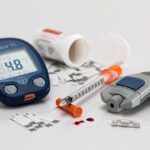Introduction: What is Prediabetes & How do you Know if you Have it?
I’m concerned I have prediabetes, something you would like to avoid. Prediabetes is a condition that falls in between the range of normal blood sugar levels and those which are high enough to be diagnosed as diabetes. Prediabetes can be caused by a variety of factors, such as being overweight or inactive, having an unhealthy diet, or simply getting older. Prediabetes is a silent killer because it does not have any symptoms at the early stages. It is important for people to know about this condition and get tested for it before it turns into type 2 diabetes which can lead to some serious complications like heart diseases and kidney failure.
There are two types of diabetes:
Type 1 – Your body doesn’t produce enough insulin
Type 2 – Your body can’t use the insulin it produces properly
The American Diabetes Association (ADA) has created a set of guidelines for those people with prediabetes. They recommend that people with prediabetes get their blood sugar levels checked every 3-6 months to track the progress of their health, it can only be detected through regular blood tests for fasting plasma glucose or HbA1c. The ADA also recommends that people with prediabetes make lifestyle changes to lower their risk of developing type 2 diabetes and cardiovascular disease.
Prediabetes is becoming more and more common in the world, with up to 86% of adults over the age of 50 having it. The condition prediabetes often goes unnoticed but can lead to diabetes and other serious health risks if left untreated. It’s important to get regular checkups and keep track of your blood glucose levels rather than dismiss the symptoms.

The symptoms of prediabetes can be mild or severe and they can vary from person to person. The most common symptoms of prediabetes include increased thirst and hunger, weight loss or gain without trying, increased urination, blurred vision, tingling in the extremities (hands and feet), dry mouth, and fatigue.
Additional risk factors for developing prediabetes:
• BMI greater than 27
• Family history of diabetes
• Sedentary lifestyle
• 45 years of age or older
• Carrying weight in your abdomen
• Previous diagnosis of gestational diabetes
How to Prevent Prediabetes from Getting Worse and Becoming Diabetes
In order to prevent prediabetes from becoming diabetes, one should make lifestyle changes with the help of a doctor. One can also take medication for prediabetes and eat a healthy diet. The United States Food and Drug Administration lists the following medications for prediabetes: metformin, acarbose, and miglitol. They are all taken two or three times a day with meals, usually in the morning before breakfast, at midday before lunch, and at night before dinner.
Prediabetes and type 2 diabetes is a lifestyle-related disease that can be prevented by changes to one’s diet, weight management, and exercise. The American Diabetes Association also states that maintaining a healthy weight is one of the most important things a person can do for their health.
The best way to reverse prediabetes is by eating healthy and exercising regularly – without these two things, you will never be able to shake the risk of having diabetes. Eating a balanced diet, and working out with moderate intensity for 30 minutes or more per day is the key to avoiding diabetes.
You are what you eat
What do you eat? Are you eating fresh foods or processed foods? High and processed foods can lead to your prediabetic condition. Watch your caloric intake. It is suggested for women start with 1400 to 1600 calories daily. Men you get to start at 2000 to 2200 calories daily. It has been shown that eating earlier in the day gives your body time to process and use the blood sugar when you are more likely to be active. If you feel the need for snacks go for something high in fiber, Some healthy snacks are:
- Hard-boiled eggs
- Almonds
- Avocado
- Beef sticks
- Turkey strips
- Whole grain chips and cheese
- Air-popped popcorn
- Nuts, seeds, and dried fruit
- peanut butter, whey protein, and oat flour bars
- Berries
- Hummus and your favorite veggie
- Apples and peanut butter
- Chickpeas
- Cottage cheese
- Tuna salad
- Black bean salad
- Celery with peanut butter

Keys to remember
A key part of controlling blood sugar levels and therefore preventing the onset of prediabetes is exercise. Exercise is a great way to improve insulin sensitivity, burn off excess glycogen, increase muscle mass and maintain a healthy weight. The lifestyle management of diabetes is not just about what you eat.
Physical activity is an important part of a healthy lifestyle. The best form of exercise for managing type 2 diabetes is a combination of aerobic exercise and strength training. It’s important that you aim for 150 minutes per week of moderate-intensity activity. You can count on a variety of activities to help you reach your goal.
In addition to brisk walking, there are examples of moderately intense exercise, such as dancing, cutting the grass, swimming, biking, and cleaning the house, as reported by the Centers for Disease Control and Prevention. One of the most important things when it comes to exercise is finding a routine that you enjoy, which makes it easier to stick with. By doing activities that you love, there will be an increased interest in getting up and moving. This leads to people being more motivated and more likely to work out regularly.
Conclusion:
I’m concerned I have prediabetes, was meant to provide you with information. Since there is no way of knowing if you are becoming or are prediabetic without checking in with your doctor, ideally a yearly physical is the first step towards keeping track of your health and preventing possible complications.
If you have been experiencing any of the symptoms that are mentioned in this article, then it is important to consult your doctor and develop a plan to monitor your glucose levels or A1c. For example, some people with type 1 diabetes may need to check their glucose levels three times a day while others with type 2 diabetes may only need to measure once a week. As you start to notice the symptoms, be proactive and examine the following lifestyle factors; healthy fats, protein, and carbohydrates.
Please join our Facebook group and check out our other blog articles.
Read more: WebMD







